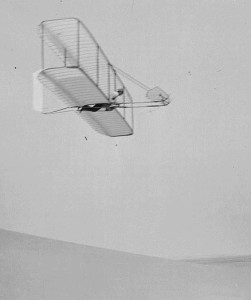

Few people are aware that rubber-power aviation was a key motivator for the Wright Brothers.
The Wright Brothers received a simple free flight rubber-powered aircraft when they were 8 and 12 years old. This fuelled their fascination for flight and they eventually embarked on a journey resulting in the invention of man made flight.
This may seem surprising but its true. In 1871, French scientist Alphonse Penaud astounded members of the French Academy of Sciences by flying a rubber-powered aircraft he called a planaphore for 131 feet. It was the first recorded flight of an inherently stable, heavier than air aircraft.
For the next 50 years, rubber-powered (then called torsion-powered) airplanes were a key research tool for aerodynamic engineers. It allowed them to test numerous configurations of flying surfaces for airworthiness without having to build full-size airplanes.

Torsion-powered aircraft also became a popular toy in the late 1800s. After Penaud’s demonstration, toy makers immediately started to create rubber-powered flying toys. One of the most popular of these toys was a torsion-powered helicopter. In 1878, Bishop Milton Wright brought this toy home to his sons Wilbur (age 12) and Orville (age 8) and started them dreaming of flight. It soon wore out, but they made copy after copy. They were still making copies to delight their nieces and nephews in 1903 just before they made their first powered flights in a real airplane.
Here are a few failed attempts at flight. You can see that Wilbur and Orville were superior problem solvers.
Elastic Rubber Band Facts. Amazing But True!
A rubber band is an extremely capable engine for an aircraft, and the science of torsion motors for model airplanes has progressed at the same amazing pace as gasoline and jet engines in real airplanes.
In 1909, as Wilbur and Orville Wright were coming home from a triumphant tour of Europe, the American record for distance flown with a rubber band-powered airplane was just over 200 feet.
In 1916, as World War 1 was at its height, Thomas Hall if the Illinois Model Aero Club flew a model 5337 feet — over a mile!
In 1924, just a few years before Lindbergh flew the Atlantic, Robert V. Jaros (also from the Illinois Model Aero Club) flew a model 7920 feet in 10 minutes and 14 seconds.
Today, model airplanes in the competitive F1D class can fly for more than 40 minutes
it was great and very informative. it surprised me with facts i never even knew!
***Note to Author: typo in opening paragraph “Few people are aware that rubber-power aviation was a key motivator or the Wright Brothers.”
I believe you meant to say “… [for] the Wright Brothers.”?
Thanks for this! It is fixed!